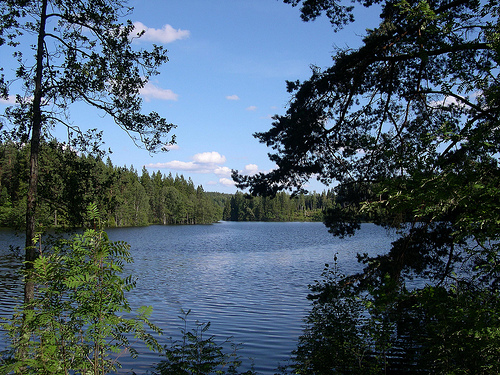

Location: Dalarna province Map
Area: 354 km²
Depth: 120 m
Lake Siljan, located in the Dalarna region of central Sweden, is the country's seventh-largest lake and a prominent feature of the Siljan Ring, a massive prehistoric impact crater. Formed approximately 377 million years ago during the Devonian period by a meteorite strike, the lake spans an area of about 354 km² when including adjacent smaller lakes like Orsasjön and Insjön, with Siljan itself covering roughly 292 km². It reaches a maximum depth of 134 meters and sits at an elevation of 161 meters above sea level, making its basin one of the deepest points in the region at 27 meters above sea level. The lake's water volume is around 42 km³, fed primarily by the Österdal River and draining into the Dal River. Known for its scenic beauty with indented wooded shores, meadows, and charming villages, Siljan is a hub for tourism, recreation, and cultural traditions, symbolizing Sweden's folk heritage. It also holds scientific interest due to its geological origins and past explorations for natural resources.
Situated at coordinates 60°51′N 14°48′E, Lake Siljan is encircled by high-relief landscapes, including a central granite dome and bordering lake basins, with towns like Mora, Leksand, and Rättvik along its shores. The lake's irregular shape features numerous islands, bays, and peninsulas, contributing to its picturesque setting. Nearby elevations, such as Gesundaberget mountain, offer panoramic views, accessible by chairlift. The region experiences a temperate climate with cold winters that often freeze the lake, enabling activities like ice skating and cross-country skiing, and mild summers ideal for boating. The surrounding terrain includes rolling blue hills, deep green forests, and well-preserved wooden villages, enhancing its appeal as a natural and cultural landmark.
Lake Siljan lies along the southwestern edge of the Siljan Ring, Europe's largest known impact structure (excluding Russia), with an original crater diameter of about 52 km, now mostly eroded. The impact, dated to around 380 million years ago, deformed Cambrian, Ordovician, and Silurian sedimentary rocks, rich in fossils, and created extensive fractures in the granite bedrock. This geology has led to deposits of lead and zinc in areas like Boda, and suspicions of oil or natural gas reserves, though explorations have been inconclusive. Recent studies of shocked igneous rocks from the site have analyzed noble gases, revealing insights into the crater's formation and post-impact processes. Deglaciation history, based on LiDAR evidence and sediment records, shows the area's complex evolution post-Ice Age, with lake levels fluctuating due to isostatic rebound and drainage changes. Noble gas analyses indicate natural gas accumulation in the fractured rocks, potentially making impact structures like Siljan hosts for hydrocarbons.
Human settlement around Siljan dates back millennia, with the region serving as a cultural heartland for Swedish folk traditions. The lake's name, of ancient and uncertain origin, may relate to terms meaning "channel" or "calm water." Post-glacial dynamics shaped the area, with sediment records indicating deglaciation patterns and subsequent lake level changes. In the 1980s, the state-owned Vattenfall company drilled deep wells (Gravberg-1 to 6,957 m and Stenberg-1 to 6,500 m) in search of natural gas, inspired by theories of abiogenic petroleum. These efforts, located in fractured granite, detected methane, hydrogen, helium, and oily magnetite but yielded no commercial production, with findings later attributed partly to drilling fluids. The projects attracted scientific attention for their insights into crustal origins of hydrocarbons. Historically, the area has been tied to folk art, including the iconic Dala Horse originating from villages around the lake.
Sweden's stringent environmental regulations have maintained high water quality in Siljan, making it one of the country's cleanest lakes. The ecosystem supports diverse flora and fauna, with surrounding forests hosting species like birch, pine, and wildlife including moose and birds. Aquatic life includes fish such as pike, perch, and trout, supporting recreational fishing and ice fishing in winter. Sediment records from the lake reveal post-deglaciation dynamics, with organic layers indicating historical vegetation and climate shifts. The area's biodiversity is enhanced by its protected status, though ongoing studies monitor potential impacts from historical mining and modern tourism.
Lake Siljan embodies Sweden's cultural soul, with red cottages, folk costumes, and Dala horses as national icons. Towns like Mora host the Zorn Museum, dedicated to artist Anders Zorn, while Rättvik features the 600-meter Långbryggan pier for scenic walks. Traditional church boat races, where crews in folk attire row long wooden vessels, highlight summer festivals. The region inspired composer Hugo Alfvén's "Midsummer Vigil," capturing its atmospheric beauty. Economically, tourism drives the area, with activities like steamship tours on M/S Gustaf Wasa, hiking, and visits to sites like Dalhalla amphitheater—a limestone quarry venue near the lake hosting concerts by artists like Björk. Folklore and traditions, including Midsummer celebrations, reinforce its status as Dalarna's heart, attracting visitors for relaxation and cultural immersion.
Today, Lake Siljan remains a vital ecological and recreational resource, with ongoing scientific research into its impact crater geology, including noble gas studies and hydrocarbon potential. Environmental monitoring ensures water quality amid tourism growth, while cultural preservation efforts maintain traditions like folk art and festivals. Recent social media highlights its scenic allure and venues like Dalhalla, underscoring its enduring appeal as a destination for nature, history, and culture in 2025.